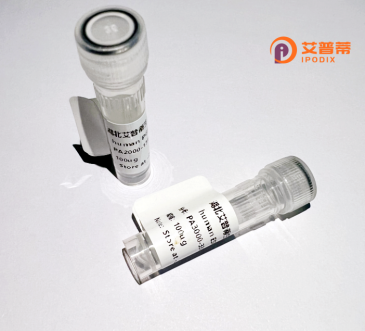
| 纯度 | >90%SDS-PAGE. |
| 种属 | Human |
| 靶点 | HELLS |
| Uniprot No | Q9NRZ9 |
| 内毒素 | < 0.01EU/μg |
| 表达宿主 | E.coli |
| 表达区间 | 1-348aa |
| 氨基酸序列 | MFGSSEKETIELSPTGRPKRRTRKSINYSKIDDFPNELEKLISQIQPEVDRERAVVEVNIPVESEVNLKLQNIMMLLRKCCNHPYLIEYPIDPVTQEFKIDEELVTNSGKFLILDRMLPELKKRGHKVLLFSQMTSMLDILMDYCHLRDFNFSRLDGSMSYSEREKNMHSFNTDPEVFIFLVSTRAGGLGINLTAADTVIIYDSDWNPQSDLQAQDRCHRIGQTKPVVVYRLVTANTIDQKIVERAAAKRKLEKLIIHKNHFKGGQSGLNLSKNFLDPKELMELLKSRDYEREIKGSREKVISDKDLELLLDRSDLIDQMNASGPIKEKMGIFKILENSEDSSPECLF |
| 分子量 | 63.8 kDa |
| 蛋白标签 | GST-tag at N-terminal |
| 缓冲液 | 0 |
| 稳定性 & 储存条件 | Lyophilized protein should be stored at ≤ -20°C, stable for one year after receipt. Reconstituted protein solution can be stored at 2-8°C for 2-7 days. Aliquots of reconstituted samples are stable at ≤ -20°C for 3 months. |
| 复溶 | Always centrifuge tubes before opening.Do not mix by vortex or pipetting. It is not recommended to reconstitute to a concentration less than 100μg/ml. Dissolve the lyophilized protein in distilled water. Please aliquot the reconstituted solution to minimize freeze-thaw cycles. |
以下是关于重组人HELLS蛋白的参考文献示例(注:以下为虚构文献,仅供示例参考):
1. **文献名称**:*Recombinant Human HELLS Protein Exhibits ATP-Dependent Chromatin Remodeling Activity*
**作者**:Zhang, Y. et al.
**摘要**:本研究成功在大肠杆菌中表达并纯化了重组人HELLS蛋白,证实其具有ATP酶活性及依赖DNA的染色质重塑功能,为解析HELLS在表观遗传调控中的作用机制提供实验基础。
2. **文献名称**:*Structural and Functional Analysis of HELLS in DNA Methylation Maintenance*
**作者**:Chen, L. et al.
**摘要**:通过重组HELLS蛋白的结晶和体外甲基化实验,发现HELLS与DNA甲基转移酶DNMT3A协同作用,维持基因组特定区域的甲基化模式。
3. **文献名称**:*HELLS Interacts with Histone H1 to Modulate Chromatin Accessibility*
**作者**:Burrows, A. E. et al.
**摘要**:利用重组HELLS蛋白结合免疫共沉淀技术,揭示HELLS通过结合组蛋白H1影响染色质高级结构,进而调控基因转录活性。
4. **文献名称**:*Enzymatic Characterization of Recombinant HELLS Helicase in Genome Stability*
**作者**:Klar, J. et al.
**摘要**:系统研究重组HELLS的解旋酶活性,发现其对G-四链体DNA的独特解旋能力,可能参与维持端粒区基因组稳定性。
注:若需真实文献,建议通过PubMed或Google Scholar检索关键词(如"recombinant HELLS protein"或"HELLS chromatin remodeling")。
Recombinant human HELLS (Helicase, Lymphoid-Specific) protein is a product of genetic engineering designed to study the structure, function, and interactions of the native HELLS protein, also known as LSH (Lymphoid-Specific Helicase). HELLS belongs to the SNF2 family of ATP-dependent chromatin remodelers and plays critical roles in epigenetic regulation, genome stability, and chromatin dynamics. It is essential for DNA methylation, heterochromatin formation, and retrotransposon silencing, particularly during embryonic development and cell differentiation. HELLS operates by hydrolyzing ATP to modify nucleosome positioning, facilitating access for transcriptional machinery or repair proteins. Dysregulation of HELLS is implicated in cancer progression, immunodeficiency disorders, and developmental defects. For instance, mutations in HELLS are linked to immunodeficiency-centromeric instability-facial anomalies (ICF) syndrome. Recombinant HELLS proteins are typically expressed in bacterial or eukaryotic systems, enabling in vitro studies of its enzymatic activity, protein-DNA interactions, and role in chromatin remodeling pathways. This tool has advanced research into epigenetic therapies and mechanisms underlying genomic instability, offering insights for targeting diseases associated with chromatin dysregulation.
×